Yamaha PSR-E233, YPT-230 User Manual
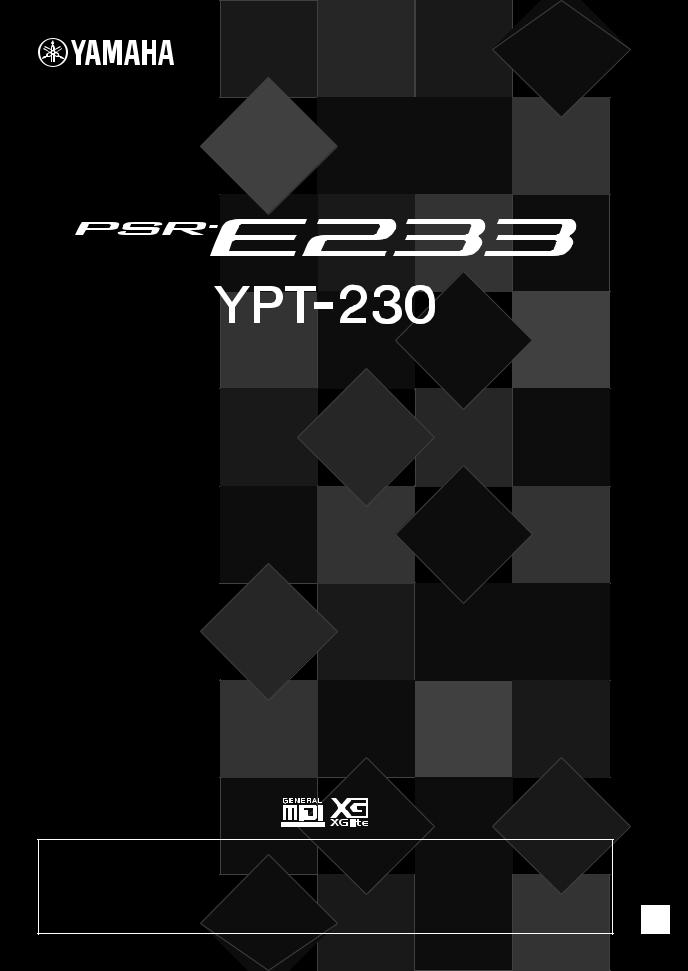
DIGITAL KEYBOARD |
Owner’s Manual |
Thank you for purchasing this Yamaha Digital Keyboard! |
|
We recommend that you read this manual carefully so that you can fully take advantage of the |
|
advanced and convenient functions of the instrument. |
|
We also recommend that you keep this manual in a safe and handy place for future reference. |
|
Before using the instrument, be sure to read “PRECAUTIONS” on pages 4–5. |
EN |

(US only)
LIMITED 1-YEAR WARRANTY ON
PORTABLE KEYBOARDS
(NP, NPV, PSRE, YPG AND YPT SERIES)
Thank you for selecting a Yamaha product. Yamaha products are designed and manufactured to provide a high level of defect-free performance. Yamaha Corporation of America (“Yamaha”) is proud of the experience and craftsmanship that goes into each and every Yamaha product. Yamaha sells its products through a network of reputable, specially authorized dealers and is pleased to offer you, the Original Owner, the following Limited Warranty, which applies only to products that have been (1) directly purchased from Yamaha’s authorized dealers in the fifty states of the USA and District of Columbia (the “Warranted Area”) and (2) used exclusively in the Warranted Area. Yamaha suggests that you read the Limited Warranty thoroughly, and invites you to contact your authorized Yamaha dealer or Yamaha Customer Service if you have any questions.
Coverage: Yamaha will, at its option, repair or replace the product covered by this warranty if it becomes defective, malfunctions or otherwise fails to conform with this warranty under normal use and service during the term of this warranty, without charge for labor or materials. Repairs may be performed using new or refurbished parts that meet or exceed Yamaha specifications for new parts. If Yamaha elects to replace the product, the replacement may be a reconditioned unit. You will be responsible for any installation or removal charges and for any initial shipping charges if the product(s) must be shipped for warranty service. However, Yamaha will pay the return shipping charges to any destination within the USA if the repairs are covered by the warranty. This warranty does not cover (a) damage, deterioration or malfunction resulting from accident, negligence, misuse, abuse, improper installation or operation or failure to follow instructions according to the Owner’s Manual for this product; any shipment of the product (claims must be presented to the carrier); repair or attempted repair by anyone other than Yamaha or an authorized Yamaha Service Center; (b) any unit which has been altered or on which the serial number has been defaced, modified or removed; (c) normal wear and any periodic maintenance; (d) deterioration due to perspiration, corrosive atmosphere or other external causes such as extremes in temperature or humidity; (e) damages attributable to power line surge or related electrical abnormalities, lightning damage or acts of God; or (f) RFI/EMI (Interference/ noise) caused by improper grounding or the improper use of either certified or uncertified equipment, if applicable. Any evidence of alteration, erasing or forgery of proof-of-purchase documents will cause this warranty to be void. This warranty covers only the Original Owner and is not transferable.
In Order to Obtain Warranty Service: Warranty service will only be provided for defective products within the Warranted Area. Contact your local authorized Yamaha dealer who will advise you of the procedures to be followed. If this is not successful, contact Yamaha at the address, telephone number or website shown below. Yamaha may request that you send the defective product to a local authorized Yamaha Servicer or authorize return of the defective product to Yamaha for repair. If you are uncertain as to whether a dealer has been authorized by Yamaha, please contact Yamaha’s Service Department at the number shown below, or check Yamaha’s website at www.Yamaha.com. Product(s) shipped for service should be packed securely and must be accompanied by a detailed explanation of the problem(s) requiring service, together with the original or a machine reproduction of the bill of sale or other dated, proof-of-purchase document describing the product, as evidence of warranty coverage. Should any product submitted for warranty service be found ineligible therefore, an estimate of repair cost will be furnished and the repair will be accomplished only if requested by you and upon receipt of payment or acceptable arrangement for payment.
Limitation of Implied Warranties and Exclusion of Damages: ANY IMPLIED WARRANTIES, INCLUDING
WARRANTIES OF MERCHANTABILITY AND FITNESS FOR A PARTICULAR PURPOSE SHALL BE LIMITED IN DURATION TO THE APPLICABLE PERIOD OF TIME SET FORTH ABOVE. YAMAHA SHALL NOT BE RESPONSIBLE FOR INCIDENTAL OR CONSEQUENTIAL DAMAGES OR FOR DAMAGES BASED UPON INCONVENIENCE, LOSS OF USE, DAMAGE TO ANY OTHER EQUIPMENT OR OTHER ITEMS AT THE SITE OF USE OR INTERRUPTION OF PERFORMANCES OR ANY CONSEQUENCES. YAMAHA’S LIABILITY FOR ANY DEFECTIVE PRODUCT IS LIMITED TO REPAIR OR REPLACEMENT OF THE PRODUCT, AT YAMAHA’S OPTION. SOME STATES DO NOT ALLOW LIMITATIONS ON HOW LONG AN IMPLIED WARRANTY LASTS OR THE EXCLUSION OR LIMITATION OF INCIDENTAL OR CONSEQUENTIAL DAMAGES, SO THE ABOVE LIMITATION OR EXCLUSION MAY NOT APPLY TO YOU. This Warranty gives you specific legal rights, and you may also have other rights which vary from state to state. This is the only express warranty applicable to the product specified herein; Yamaha neither assumes nor authorizes anyone to assume for it any other express warranty.
If you have any questions about service received or if you need assistance in locating an authorized Yamaha Servicer, please contact:
CUSTOMER SERVICE
Yamaha Corporation of America
6600 Orangethorpe Avenue, Buena Park, California 90620-1373
Telephone: 800-854-1569 www.yamaha.com
Do not return any product to the above address without a written Return Authorization issued by YAMAHA.
©2009 Yamaha Corporation of America.
2 PSR-E233/YPT-230 Owner’s Manual

SPECIAL MESSAGE SECTION
This product utilizes batteries or an external power supply (adapter). DO NOT connect this product to any power supply or adapter other than one described in the manual, on the name plate, or specifically recommended by Yamaha.
WARNING: Do not place this product in a position where anyone could walk on, trip over, or roll anything over power or connecting cords of any kind. The use of an extension cord is not recommended! If you must use an extension cord, the minimum wire size for a 25’ cord (or less) is 18 AWG. NOTE: The smaller the AWG number, the larger the current handling capacity. For longer extension cords, consult a local electrician.
This product should be used only with the components supplied or; a cart, rack, or stand that is recommended by Yamaha. If a cart, etc., is used, please observe all safety markings and instructions that accompany the accessory product.
SPECIFICATIONS SUBJECT TO CHANGE:
The information contained in this manual is believed to be correct at the time of printing. However, Yamaha reserves the right to change or modify any of the specifications without notice or obligation to update existing units.
This product, either alone or in combination with an amplifier and headphones or speaker/s, may be capable of producing sound levels that could cause permanent hearing loss. DO NOT operate for long periods of time at a high volume level or at a level that is uncomfortable. If you experience any hearing loss or ringing in the ears, you should consult an audiologist.
IMPORTANT: The louder the sound, the shorter the time period before damage occurs.
Some Yamaha products may have benches and / or accessory mounting fixtures that are either supplied with the product or as optional accessories. Some of these items are designed to be dealer assembled or installed. Please make sure that benches are stable and any optional fixtures (where applicable) are well secured BEFORE using.
Benches supplied by Yamaha are designed for seating only. No other uses are recommended.
NOTICE:
Service charges incurred due to a lack of knowledge relating to how a function or effect works (when the unit is operating as designed) are not covered by the manufacturer’s warranty, and are therefore the owners responsibility. Please study this manual carefully and consult your dealer before requesting service.
ENVIRONMENTAL ISSUES:
Yamaha strives to produce products that are both user safe and environmentally friendly. We sincerely believe that our products and the production methods used to produce them, meet these goals. In keeping with both the letter and the spirit of the law, we want you to be aware of the following:
Battery Notice:
This product MAY contain a small non-rechargeable battery which (if applicable) is soldered in place. The average life span of this type of battery is approximately five years. When replacement becomes necessary, contact a qualified service representative to perform the replacement.
This product may also use “household” type batteries. Some of these may be rechargeable. Make sure that the battery being charged is a rechargeable type and that the charger is intended for the battery being charged.
When installing batteries, never mix old batteries with new ones, and never mix different types of batteries. Batteries MUST be installed correctly. Mismatches or incorrect installation may result in overheating and battery case rupture.
Warning:
Do not attempt to disassemble, or incinerate any battery. Keep all batteries away from children. Dispose of used batteries promptly and as regulated by the laws in your area. Note: Check with any retailer of household type batteries in your area for battery disposal information.
Disposal Notice:
Should this product become damaged beyond repair, or for some reason its useful life is considered to be at an end, please observe all local, state, and federal regulations that relate to the disposal of products that contain lead, batteries, plastics, etc. If your dealer is unable to assist you, please contact Yamaha directly.
NAME PLATE LOCATION:
The name plate is located on the bottom of the product. The model number, serial number, power requirements, etc., are located on this plate. You should record the model number, serial number, and the date of purchase in the spaces provided below and retain this manual as a permanent record of your purchase.
Model
Serial No.
Purchase Date
PLEASE KEEP THIS MANUAL
92-BP (bottom)
FCC INFORMATION (U.S.A.)
1.IMPORTANT NOTICE: DO NOT MODIFY THIS UNIT!
This product, when installed as indicated in the instructions contained in this manual, meets FCC requirements. Modifications not expressly approved by Yamaha may void your authority, granted by the FCC, to use the product.
2.IMPORTANT: When connecting this product to accessories and/ or another product use only high quality shielded cables. Cable/s supplied with this product MUST be used. Follow all installation instructions. Failure to follow instructions could void your FCC authorization to use this product in the USA.
3.NOTE: This product has been tested and found to comply with the requirements listed in FCC Regulations, Part 15 for Class “B” digital devices. Compliance with these requirements provides a reasonable level of assurance that your use of this product in a residential environment will not result in harmful interference with other electronic devices. This equipment generates/uses radio frequencies and, if not installed and used according to the instructions found in the users manual, may cause interference harmful to the operation of other electronic devices. Compliance with FCC regulations does
not guarantee that interference will not occur in all installations. If this product is found to be the source of interference, which can be determined by turning the unit “OFF” and “ON”, please try to eliminate the problem by using one of the following measures:
Relocate either this product or the device that is being affected by the interference.
Utilize power outlets that are on different branch (circuit breaker or fuse) circuits or install AC line filter/s.
In the case of radio or TV interference, relocate/reorient the antenna. If the antenna lead-in is 300 ohm ribbon lead, change the lead-in to co-axial type cable.
If these corrective measures do not produce satisfactory results, please contact the local retailer authorized to distribute this type of product. If you can not locate the appropriate retailer, please contact Yamaha Corporation of America, Electronic Service Division, 6600 Orangethorpe Ave, Buena Park, CA90620
The above statements apply ONLY to those products distributed by Yamaha Corporation of America or its subsidiaries.
* This applies only to products distributed by YAMAHA CORPORATION OF AMERICA. |
(class B) |
PSR-E233/YPT-230 Owner’s Manual 3

PRECAUTIONS
PLEASE READ CAREFULLY BEFORE PROCEEDING
* Please keep this manual in a safe place for future reference.
 WARNING
WARNING
Always follow the basic precautions listed below to avoid the possibility of serious injury or even death from electrical shock, shortcircuiting, damages, fire or other hazards. These precautions include, but are not limited to, the following:
Power supply/AC power adaptor |
Battery |
•Do not place the power cord near heat sources such as heaters or radiators, and do not excessively bend or otherwise damage the cord, place heavy objects on it, or place it in a position where anyone could walk on, trip over, or roll anything over it.
•Only use the voltage specified as correct for the instrument. The required voltage is printed on the name plate of the instrument.
•Use the specified adaptor (page 42) only. Using the wrong adaptor can result in damage to the instrument or overheating.
•Check the electric plug periodically and remove any dirt or dust which may have accumulated on it.
Do not open
•This instrument contains no user-serviceable parts. Do not open the instrument or attempt to disassemble or modify the internal components in any way. If it should appear to be malfunctioning, discontinue use immediately and have it inspected by qualified Yamaha service personnel.
Water warning
•Do not expose the instrument to rain, use it near water or in damp or wet conditions, or place containers on it containing liquids which might spill into any openings. If any liquid such as water seeps into the instrument, turn off the power immediately and unplug the power cord from the AC outlet. Then have the instrument inspected by qualified Yamaha service personnel.
•Never insert or remove an electric plug with wet hands.
Fire warning
•Do not put burning items, such as candles, on the unit. A burning item may fall over and cause a fire.
•Always replace all batteries at the same time. Do not use new batteries together with old ones.
•Do not mix battery types, such as alkaline batteries with manganese batteries, or batteries from different makers, or different types of batteries from the same maker, since this can cause overheating, fire, or battery fluid leakage.
•Do not tamper with or disassemble batteries.
•Do not dispose of batteries in fire.
•Do not attempt to recharge batteries that are not intended to be charged.
•Keep batteries away from children.
•If the batteries do leak, avoid contact with the leaked fluid. If the battery fluid should come in contact with your eyes, mouth, or skin, wash immediately with water and consult a doctor. Battery fluid is corrosive and may possibly cause loss of sight or chemical burns.
•Always make sure all batteries are inserted in conformity with the +/- polarity markings. Failure to do so might result in overheating, fire, or battery fluid leakage.
•When the batteries run out, or if the instrument is not to be used for a long time, remove the batteries from the instrument to prevent possible leakage of the battery fluid.
If you notice any abnormality
•When one of the following problems occur, immediately turn off the power switch and disconnect the electric plug from the outlet. (If you are using batteries, remove all batteries from the instrument.) Then have the device inspected by Yamaha service personnel.
•The power cord or plug becomes frayed or damaged.
•It emits unusual smells or smoke.
•Some object has been dropped into the instrument.
•There is a sudden loss of sound during use of the instrument.
 CAUTION
CAUTION
Always follow the basic precautions listed below to avoid the possibility of physical injury to you or others, or damage to the instrument or other property. These precautions include, but are not limited to, the following:
Power supply/AC power adaptor |
Connections |
•Do not connect the instrument to an electrical outlet using a multiple-connector. Doing so can result in lower sound quality, or possibly cause overheating in the outlet.
•When removing the electric plug from the instrument or an outlet, always hold the plug itself and not the cord. Pulling by the cord can damage it.
•Remove the electric plug from the outlet when the instrument is not to be used for extended periods of time, or during electrical storms.
Location
•Do not place the instrument in an unstable position where it might accidentally fall over.
•Before moving the instrument, remove all connected cables.
•When setting up the product, make sure that the AC outlet you are using is easily accessible. If some trouble or malfunction occurs, immediately turn off the power switch and disconnect the plug from the outlet. Even when the power switch is turned off, electricity is still flowing to the product at the minimum level. When you are not using the product for a long time, make sure to unplug the power cord from the wall AC outlet.
•Use only the stand specified for the instrument. When attaching the stand or rack, use the provided screws only. Failure to do so could cause damage to the internal components or result in the instrument falling over.
•Before connecting the instrument to other electronic components, turn off the power for all components. Before turning the power on or off for all components, set all volume levels to minimum.
•Be sure to set the volumes of all components at their minimum levels and gradually raise the volume controls while playing the instrument to set the desired listening level.
Handling caution
•Do not insert a finger or hand in any gaps on the instrument.
•Never insert or drop paper, metallic, or other objects into the gaps on the panel or keyboard. This could cause physical injury to you or others, damage to the instrument or other property, or operational failure.
•Do not rest your weight on, or place heavy objects on the instrument, and do not use excessive force on the buttons, switches or connectors.
•Do not use the instrument/device or headphones for a long period of time at a high or uncomfortable volume level, since this can cause permanent hearing loss. If you experience any hearing loss or ringing in the ears, consult a physician.
DMI-3 1/2
4 PSR-E233/YPT-230 Owner’s Manual

Yamaha cannot be held responsible for damage caused by improper use or modifications to the instrument, or data that is lost or destroyed.
Always turn the power off when the instrument is not in use.
Even when the power switch is in standby status, electricity is still flowing to the instrument at the minimum level. When you are not using the instrument for a long time, make sure you unplug the power cord from the wall AC outlet.
Make sure to discard used batteries according to local regulations.
NOTICE
To avoid the possibility of malfunction/damage to the product, damage to data, or damage to other property, follow the notices below.
Handling and Maintenance
•Do not use the instrument in the vicinity of a TV, radio, stereo equipment, mobile phone, or other electric devices. Otherwise, the instrument, TV, or radio may generate noise.
•Do not expose the instrument to excessive dust or vibrations, or extreme cold or heat (such as in direct sunlight, near a heater, or in a car during the day) to prevent the possibility of panel disfiguration, damage to the internal components or unstable operation. (Verified operating temperature range: 5° – 40°C, or 41° – 104°F.)
•Do not place vinyl, plastic or rubber objects on the instrument, since this might discolor the panel or keyboard.
•When cleaning the instrument, use a soft, dry cloth. Do not use paint thinners, solvents, cleaning fluids, or chemical-impregnated wiping cloths.
About copyrights
•Copying of the commercially available musical data including but not limited to MIDI data and/or audio data is strictly prohibited except for your personal use.
•This product incorporates and bundles computer programs and contents in which Yamaha owns copyrights or with respect to which it has license to use others’ copyrights. Such copyrighted materials include, without limitation, all computer software, style files, MIDI files, WAVE data, musical scores and sound recordings. Any unauthorized use of such programs and contents outside of personal use is not permitted under relevant laws. Any violation of copyright has legal consequences. DON’T MAKE, DISTRIBUTE OR USE ILLEGAL COPIES.
About functions/data bundled with the instrument
•Some of the preset songs have been edited for length or arrangement, and may not be exactly the same as the original.
About this manual
•The illustrations and LCD screens as shown in this manual are for instructional purposes only, and may appear somewhat different from those on your instrument.
•The company names and product names in this manual are the trademarks or registered trademarks of their respective companies.
DMI-3 2/2
PSR-E233/YPT-230 Owner’s Manual 5
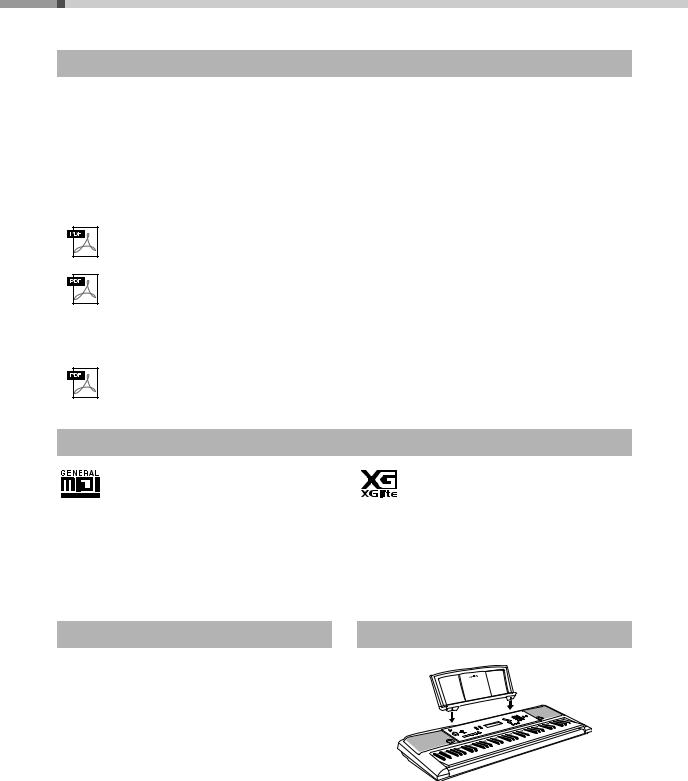
About the Manuals
This instrument has the following documents and instructional materials.
Included Documents
Owner’s Manual (this book)
Online Materials (Downloadable from the web)
The following instructional materials are available for downloading from the Yamaha website.
Yamaha Manual Library http://www.yamaha.co.jp/manual/
Access the Yamaha Manual Library, then enter your model name (PSR-E233, for example) in the Model Name area to search the manuals.
MIDI Data Format
This document contains both the MIDI Data Format and the MIDI Implementation Chart.
MIDI Basics (only in English, French, German and Spanish)
If you want to know more about MIDI and how to use it, refer to this introductory book.
Yamaha Online Member https://member.yamaha.com/myproduct/regist/
You can refer to the music score in the Song Book (free downloadable scores). To obtain the Song Book, complete the user registration at the above website.
Song book (only in English, French, German and Spanish)
Logos
GM System Level 1
“GM System Level 1” is an addition to the MIDI standard which ensures that any GM-compatible music data can be accurately played by any GMcompatible tone generator, regardless of manufacturer. The GM mark is affixed to all software and hardware products that support GM System Level.
XGlite
As its name implies, “XGlite” is a simplified version of Yamaha’s high-quality XG tone generation format. Naturally, you can play back any XG song data using an XGlite tone generator. However, keep in mind that some songs may play back differently compared to the original data, due to the reduced set of control parameters and effects.
Supplied Accessories
•Owner’s manual (this book)
•Music rest
•AC Power Adaptor
* May not be included depending on your particular area. Please check with your Yamaha dealer.
•My Yamaha Product User Registration
*The PRODUCT ID on the sheet will be needed when you fill out the User Registration form.
Using the music rest
Insert the music rest into the slots as shown.
6 PSR-E233/YPT-230 Owner’s Manual

Contents
About the Manuals................................................ |
6 |
Logos.................................................................... |
6 |
Supplied Accessories ........................................... |
6 |
Using the music rest ............................................. |
6 |
Introduction |
|
Setting Up |
8 |
Power Requirements ............................................ |
8 |
Connecting headphones and external audio |
|
equipment........................................................ |
9 |
Connecting a footswitch ....................................... |
9 |
Turn on the power ................................................ |
9 |
Auto Power Off function........................................ |
9 |
Panel Controls and Terminals |
10 |
Basic Operation and Displays |
12 |
Basic Operation .................................................. |
12 |
Display................................................................ |
13 |
Reference |
|
Try Playing a Variety of Instrument Voices 14 |
|
Select and Play a Voice...................................... |
14 |
Playing the Grand Piano Voice........................... |
15 |
Fun Sounds ........................................................ |
15 |
Try playing with enhanced, dynamic sound |
|
(Ultra-Wide Stereo)........................................ |
15 |
Play with a Style |
16 |
Select a Style Rhythm ........................................ |
16 |
Play Along with a Style ....................................... |
17 |
Pattern Variation (Sections)................................ |
18 |
Chords ................................................................ |
19 |
Looking up Chords Using the Chord Dictionary . 20 |
|
Try Playing a Song with a Style!......................... |
21 |
Playing Songs |
22 |
Select and Listen to a Specific Song .................. |
22 |
Listening to the Demo Songs ............................. |
23 |
BGM Playback.................................................... |
23 |
Using the Lesson Feature |
24 |
Song Lesson....................................................... |
24 |
A-B Repeat......................................................... |
26 |
Mute.................................................................... |
26 |
Using the Metronome ......................................... |
27 |
Changing the Tempo .......................................... |
27 |
Function Settings |
28 |
Select the item and change the value ................. |
28 |
About MIDI |
31 |
What is MIDI?...................................................... |
31 |
Transferring Performance Data To and From |
|
Another Instrument......................................... |
31 |
Appendix |
|
Troubleshooting............................................. |
32 |
Voice List ........................................................ |
33 |
Drum Kit List .................................................. |
37 |
Song List......................................................... |
39 |
Style List ......................................................... |
40 |
Effect Type List .............................................. |
41 |
Specifications................................................. |
42 |
Index................................................................ |
43 |
PSR-E233/YPT-230 Owner’s Manual 7
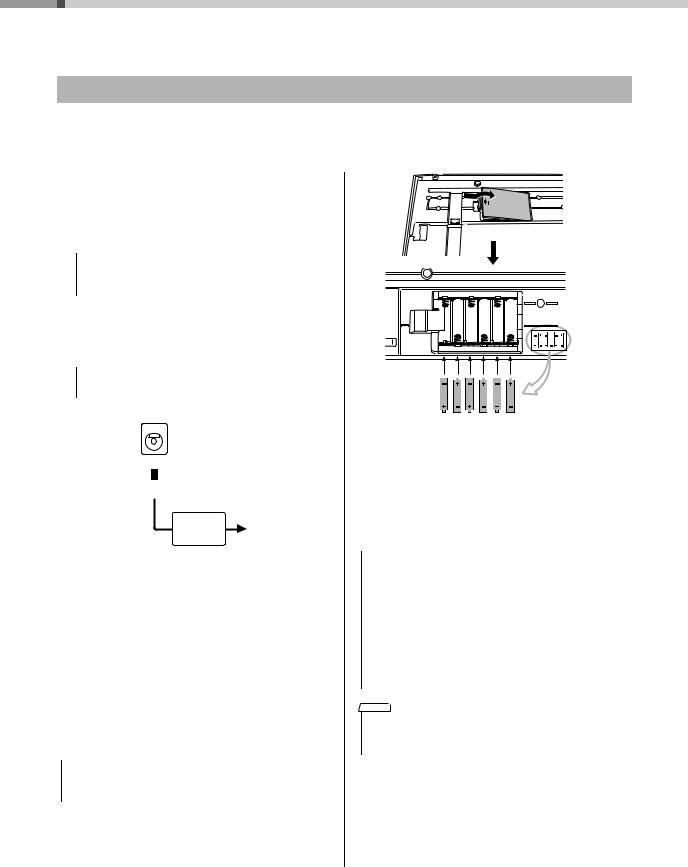
Setting Up
Be sure to do the following operations BEFORE turning on the power.
Power Requirements
Although the instrument will run either from an optional AC adaptor or batteries, Yamaha recommends use of an AC adaptor whenever possible. An AC adaptor is more environmentally friendly than batteries and does not deplete resources.
Using an AC Power Adaptor
1Make sure that the [ ] (Standby/On) switch of the instrument is off (display is blank, except for nota-
] (Standby/On) switch of the instrument is off (display is blank, except for nota-
tion staff).
 WARNING
WARNING
•Use the specified adaptor (page 42). The use of other adaptors may result in irreparable damage to both the adaptor and the instrument.
2Connect the AC power adaptor to the power supply jack.
3Plug the AC adaptor into an AC outlet.
 CAUTION
CAUTION
•Unplug the AC Power Adaptor when not using the instrument, or during electrical storms.
2
|
|
|
AC power |
3 |
|
|
|
||
|
|
|
||
|
|
|
||
|
|
|
AC outlet |
|
|
|
|
adaptor |
|
|
|
|
|
Using Batteries
1Open the battery compartment cover located on the instrument’s bottom panel.
2Insert the six new alkaline batteries, being careful to follow the polarity markings on the side of the compartment.
3Replace the compartment cover, making sure that it locks firmly in place.
NOTICE
•Never connect or disconnect the AC power adaptor when the batteries are installed in the instrument and the power is on. Doing so will turn the power off.
For battery operation the instrument requires six 1.5V “AA” size, LR6 or equivalent batteries. (Alkaline batteries are recommended.) When battery power becomes too low for proper operation, the volume may be reduced, the sound may be distorted, and other problems may occur. When this happens, make sure to replace all batteries, following the precautions listed below.
 WARNING
WARNING
•Make sure to install the batteries with the proper orientation, maintaining the correct polarity (as shown). Incorrect battery installation may result in heat, fire and/or leaking of corrosive chemicals.
•When the batteries run down, replace them with a complete set of six new batteries. NEVER mix old and new batteries. Do not use different kinds of batteries (e.g. alkaline and manganese) at the same time.
•If the instrument is not to be in use for a long time, remove the batteries from it, in order to prevent possible fluid leakage from the battery.
NOTE
•Use alkaline batteries for this instrument. Other types of batteries (including rechargeable batteries) may have sudden drops of power when battery power becomes low.
8 PSR-E233/YPT-230 Owner’s Manual
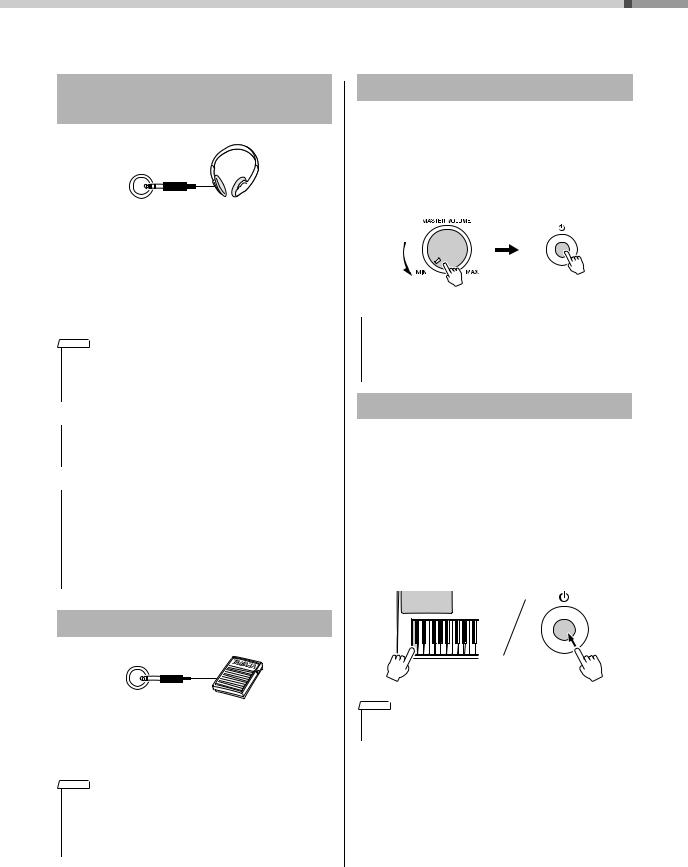
Setting Up
Make all necessary connections BEFORE turning the power on.
Connecting headphones and external audio equipment
You can connect the PHONES/OUTPUT jack to a set of headphones, keyboard amplifier, stereo system, mixer, tape recorder, or other line-level audio device to send the instrument’s output signal to that device.
The internal speakers are automatically shut off when a plug is inserted into this jack. The PHONES/OUTPUT jack also functions as an external output.
NOTE
•You can set the Master equalizer (EQ) which is provided to give you the best possible sound when listening through different reproduction systems. The Master equalizer (EQ) can be set in the Function settings (page 29 Function 013).
 CAUTION
CAUTION
•Avoid listening with the headphones at high volume for long periods of time; doing so may not only result in ear fatigue, it may be damaging to your hearing.
 CAUTION
CAUTION
•To prevent damage to the speakers, set the volume of the external devices at the minimum setting and turn power off the devices before connecting them. Failure to observe these precautions may result in electric shock or equipment damage. Also, be sure to set the volumes of all devices at their minimum levels and gradually raise the volume controls while playing the instrument to set the desired listening level.
Connecting a footswitch
The sustain function lets you produce a natural sustain as you play by pressing an optional footswitch. Plug the Yamaha FC4 or FC5 footswitch into the SUSTAIN jack and use it to switch sustain on and off.
NOTE
•Make sure that the footswitch plug is properly connected to the SUSTAIN jack before turning on the power.
•Do not press the footswitch while turning the power on. Doing this changes the recognized polarity of the footswitch, resulting in reversed footswitch operation.
Turn on the power
Turn down the volume by turning the [MASTER VOLUME] control to the left and press the [ ] (Standby/On) switch to turn on the power. While playing the keyboard, adjust the volume level by using the [MASTER VOLUME] control. Pressing the [
] (Standby/On) switch to turn on the power. While playing the keyboard, adjust the volume level by using the [MASTER VOLUME] control. Pressing the [  ] (Standby/On) switch again turns the power off.
] (Standby/On) switch again turns the power off.
 CAUTION
CAUTION
•When using a power adaptor, even when the power is off, a small amount of electricity is still being consumed by the instrument. When you are not using the instrument for a long time, make sure to unplug the AC power adaptor from the wall AC outlet, and/or remove the batteries from the instrument.
Auto Power Off function
To prevent unnecessary power consumption, this instrument features an Auto Power Off function that automatically turns the power off if the instrument is not used for approximately 30 minutes.
To disable the Auto Power Off function
While holding down the lowest key, press the [ ] (Standby/On) switch to turn on the power. Alternately select “Off” in the Function settings (page 30 Function 024).
] (Standby/On) switch to turn on the power. Alternately select “Off” in the Function settings (page 30 Function 024).
NOTE
•Any settings will be restored to the factory default settings when the power is turned off.
PSR-E233/YPT-230 Owner’s Manual 9
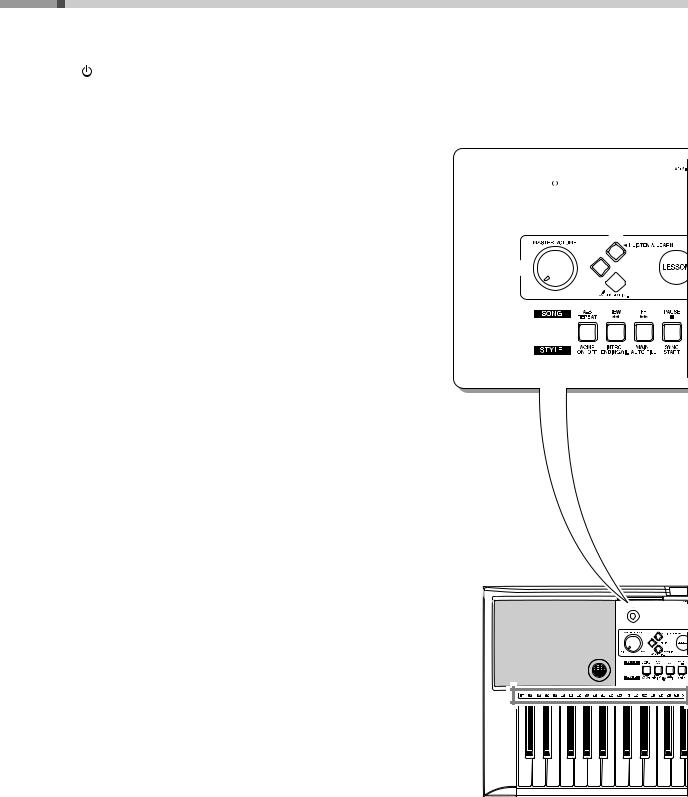
Panel Controls and Terminals
Front Panel
q [ ] (Standby/On) switch..................................... |
page 9 |
|
w [MASTER VOLUME] control ................................ |
page 9 |
|
e [1 LISTEN & LEARN] button.............................. |
page 24 |
|
r [2 TIMING] button............................................... |
page 24 |
|
t [3 WAITING] button ............................................ |
page 24 |
|
y LESSON PART |
|
|
[L] button ............................................................ |
page 25 |
|
[R] button............................................................ |
page 25 |
|
u [METRONOME] button....................................... |
page 27 |
|
i [TEMPO/TAP] button.......................................... |
page 27 |
|
o [SONG] button............................................ |
pages 12, 22 |
|
!0[VOICE] button ........................................... |
pages 12, 14 |
|
!1[STYLE] button ........................................... |
pages 12, 16 |
|
!2Number buttons [0]–[9], [+], [-] ......................... |
page 12 |
|
!3[FUNCTION] button............................................ |
page 28 |
|
!4[DEMO/BGM] button .......................................... |
page 23 |
|
|
|
|
In the Song mode |
|
|
|
|
|
!5[A-B REPEAT] button......................................... |
page 26 |
|
!6[REW] button ...................................................... |
page 22 |
|
!7[FF] button .......................................................... |
page 22 |
|
!8[PAUSE] button................................................... |
page 22 |
|
|
|
|
In the Style mode |
|
|
|
|
|
!5[ACMP ON/OFF] button ..................................... |
page 17 |
|
!6[INTRO/ENDING/rit.] button............................... |
page 18 |
|
!7[MAIN/AUTO FILL] button.................................. |
page 18 |
|
!8[SYNC START] button ........................................ |
page 17 |
|
|
|
|
!9[START/STOP] button ................................ |
pages 12, 22 |
|
@0[PORTABLE GRAND] button ............................. |
page 15 |
|
@1[SOUND EFFECT] button .................................. |
page 15 |
|
@2[ULTRA-WIDE STEREO] button ........................ |
page 15 |
|
@3Drum Kit.............................................................. |
page 14 |
|
Rear Panel |
|
|
@4MIDI IN/OUT terminals ....................................... |
page 31 |
|
@5SUSTAIN jack ....................................................... |
page 9 |
|
@6PHONES/OUTPUT jack........................................ |
page 9 |
|
@7DC IN jack ............................................................. |
page 8 |
|
Front Panel
q
e
r
w 





 t
t




!6 !8
@3 |
10 PSR-E233/YPT-230 Owner’s Manual
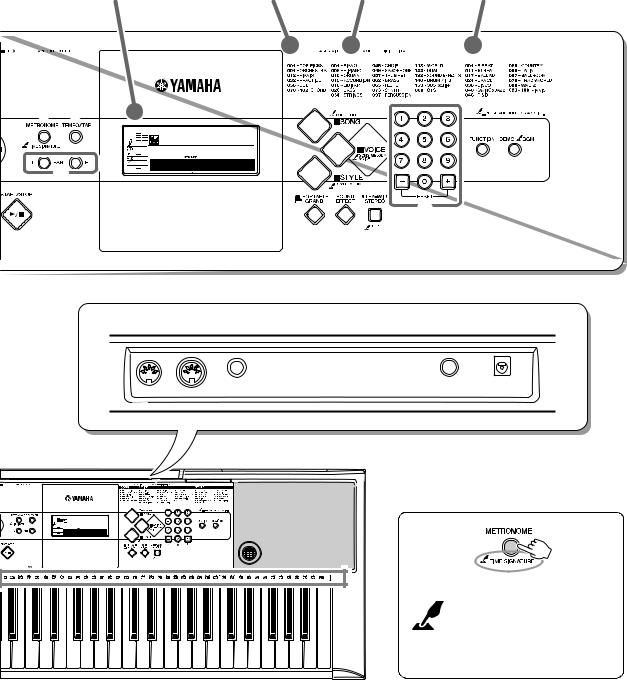
Panel Controls and Terminals
|
|
|
|
|
|
|
|
|
|
|
|
|
|
Display (page 13) |
Song List (page 39) |
|
Voice List (page 33) |
|
Style List (page 40) |
||||||||
|
|
|
|
|
|
|
|
|
|
|
|
|
|
|
|
|
|
|
|
|
|
|
|
|
|
|
|
|
|
|
|
|
|
|
|
|
|
|
|
|
|
u |
i |
|
|
|
o |
|
|
|
!0 |
|
|
y |
!1 |
!3 |
!4 |
|
|
||
|
|
!2 |
|
@0@1 |
@2 |
!9 |
|
Rear Panel
 @4 @5 @6 @7
@4 @5 @6 @7
PSR-E233/YPT-230 Owner’s Manual 11

Basic Operation and Displays
Basic Operation
Press a button to select a basic function: Voice, Style or Song. To change the instrument voice that sounds when you play the keyboard, press the [VOICE] button. If you want to play along with auto accompaniment, press the [STYLE] button. If you want to listen to a song, press the [SONG] button.
3Display (page 13)


 001 GrandPno
001 GrandPno

 001
001
1 |
2 |
1
2
Select a basic function.
[SONG] button .............. |
To select a Song. |
[VOICE] button .............. |
To select a Voice. |
[STYLE] button.............. |
To select a Style. |
When you select a basic function, the name and number of the currently selected Song, Style or Voice is shown.
Select an item or value by using the number buttons [0]–[9], [+], [-].
Refer to the Song, Voice and Style Lists on pages 33–40.
Number buttons [0]–[9]
The number buttons can be used to directly enter a Song, Style or Voice number or parameter value. For numbers that start with one or two zeroes, the first zeroes can be omitted.
Example:
Selecting Voice 002,
Grand Piano2.
[+], [-] buttons
Press the [+] button briefly to increase the value by 1, or press the [-] button briefly to decrease the value by 1. Press and hold either button to continuously increase or decrease the value in the corresponding direction.
Press number buttons |
Press briefly to |
Press briefly to |
|
decrease. |
increase. |
||
[0], [0], [2]. |
|||
|
|
3 Start a function or play the keyboard.
Voice ............................. |
Play the keyboard. |
Song ............................. |
Press the [START/STOP] button to play Songs. |
Style.............................. |
Press the [START/STOP] button to play the Style rhythm. |
You can stop playback at any time by pressing the [START/STOP] button.
12 PSR-E233/YPT-230 Owner’s Manual
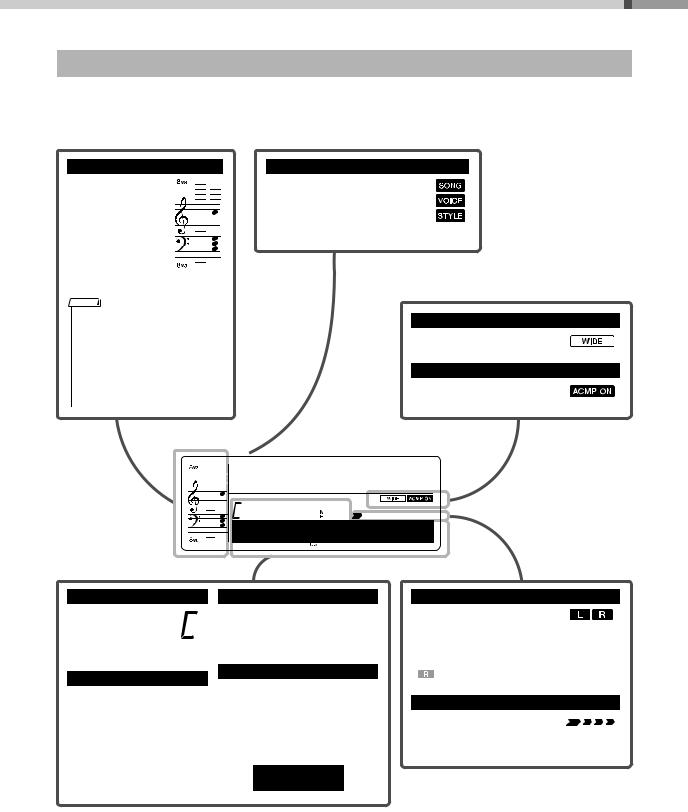
Basic Operation and Displays
Display
The Main display shows all of the current basic settings for Song, Style and Voice. It also includes a range of indicators that show the on/off status for various functions.
Notation |
SONG/VOICE/STYLE |
Displays the melody and chord notes of a Song when the Song lesson function is in use, or the notes of chords you specify when the Dictionary function is in use. At other times the notes you play on the keyboard are displayed.
NOTE
•Any notes occurring below or above the staff are indicated by “8va” in the notation.
•For a few specific chords, not all notes may be shown in the notation section of the display. This is due to space limitations in the display.
Indicate the operating condition of the instrument (page 12).
ULTRA-WIDE STEREO
Appears when ULTRA-WIDE
STEREO is on (page 15).
ACMP ON
Appears when the auto accompaniment is on (page 17).

 001 GrandPno
001 GrandPno

 003
003 

Chord Display
Indicates the name of the chord currently being played back, or the name of the chord
being played on the keyboard.
Measure
Indicates the current measure during playback of a Song.

 003
003
Function
Indicates the Function number when the Function is in use.

 027
027
Keyboard Display
Indicates notes currently being played. Indicates the melody and chord notes of a Song when the Song lesson function is in use. Also indicates the notes of a chord—either when playing a chord or when using the Dictionary function.
Song track display
Information related to the Song tracks is shown here. (See page 26.)
 Lit: Track contains data
Lit: Track contains data
Unlit: Track is muted or contains no data
Beat Display
Indicates the beat of the current Style or Song with flashing arrows.
PSR-E233/YPT-230 Owner’s Manual 13
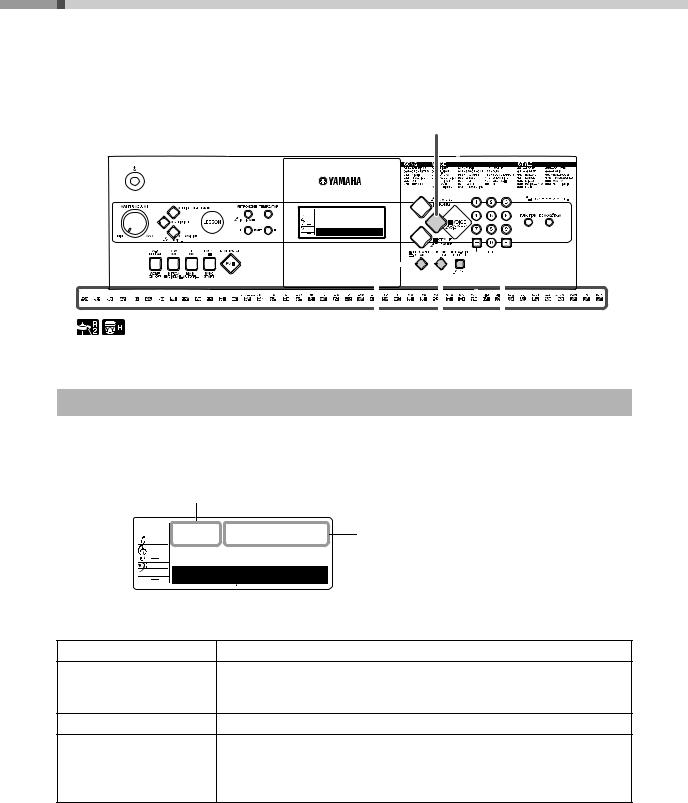
Try Playing a Variety of Instrument Voices
This instrument features a variety of realistic, built-in voices. The grand piano Voice is automatically selected whenever the power is turned on, but you can easily change this to guitar, drums, or any of an extensive range of voices.
Voice


 001 GrandPno
001 GrandPno

 001
001
|
|
|
|
|
|
|
|
|
|
|
|
|
|
|
|
|
|
|
|
|
|
|
|
|
|
|
|
|
|
|
|
|
|
|
|
|
|
|
|
|
|
|
|
|
Percussion and drum icons |
Grand Piano |
SOUND |
Ultra-Wide |
|||||
|
|
|
Voice |
EFFECT |
Stereo |
|||
Select and Play a Voice
Press the [VOICE] button and then select the desired Voice, referring to the section “Basic Operation” on page 12 for instructions.
Refer to the Voice List on page 33.
Voice number


 001 GrandPno
001 GrandPno



 001
001
Voice name
The Voice shown here becomes the Main Voice for the instrument.
Preset Voice Types
001–139 |
Instrument Voices |
Various drum and percussion sounds are assigned to individual keys, from 140–152 (Drum Kit) which they can be played. Details on the instruments and key assignments of
each Drum Kit can be found in the Drum Kit List on page 37.
153–385 |
XGlite Voices |
One Touch Setting (OTS)
000
The One Touch Setting feature automatically selects the most suitable Voice for you when you select a Style or Song. Simply select Voice number “000” to activate this feature.
14 PSR-E233/YPT-230 Owner’s Manual

Try Playing a Variety of Instrument Voices
Playing the Grand Piano Voice
When you simply want to play a piano Voice, all you have to do is press one convenient button.
Press the [PORTABLE GRAND] button.
The Voice “Grand Piano” will automatically be selected as the Main Voice.
Fun Sounds
You’ll be able to play various sound effects from the keyboard: barking, braying, yelling, and much more.
Press the [SOUND EFFECT] button.
Try out each key and enjoy the sounds. Don’t forget the black keys!
After trying out these sounds, press the [PORTABLE GRAND] button to reset the instrument Voice to the default setting of Voice “Grand Piano1.”
Try playing with enhanced, dynamic sound (Ultra-Wide Stereo)
You can play the keyboard with a spacious, dynamic sound effect that gives you the sensation of hearing the sound outside of the speakers.
Turn on the Ultra-Wide Stereo effect, and hear the sound expand around you—as if the speaker position is outside of the instrument.
Press the [ULTRA-WIDE STEREO] button.
GrandPno
001 |
Appears when Ultra-Wide Stereo is on. |
|
To turn ULTRA-WIDE STEREO off, press the [ULTRA-WIDE STEREO] button again.
NOTE
•The wide effect type can be set in the Function settings (page 29 Function 014).
SHORTCUT
You can jump directly to the Functions Settings by pressing and holding the [ULTRAWIDE STEREO] button for longer than a second.
Adding other effects to the sound
You can also play the sounds of the instrument adding Reverb, Chorus and Sustain.
The best-suited Reverb and Chorus type is automatically selected whenever you select a Song or Style, but you can select any of the available Reverb or Chorus Types. These effects can be set in the Function setting (page 29). Refer to the Reverb and Chorus Type lists on page 41 for details.
Reverb........................ |
This effect adds the ambience of a room or concert hall to the sound. |
Chorus........................ |
This effect makes the Voice sound richer, warmer and more spacious. |
Panel Sustain ............. |
This function adds a fixed sustain to the keyboard Voices. |
The sustain function can also be applied with the optional footswitch (page 9).
PSR-E233/YPT-230 Owner’s Manual 15
